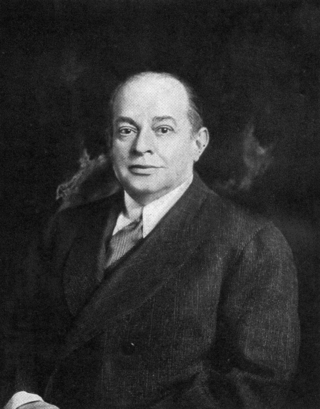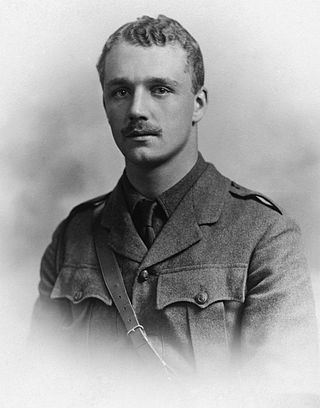Related Research Articles
This article contains information about the literary persons, events and publications of 1915.

The Secret Adversary is the second published detective fiction novel by British writer Agatha Christie, first published in January 1922 in the United Kingdom by The Bodley Head and in the United States by Dodd, Mead and Company later in that same year. The UK edition retailed at seven shillings and sixpence (7/6) and the US edition at $1.75.

RMS Lusitania was a British ocean liner launched by the Cunard Line in 1906. She was the world's largest passenger ship until the completion of the Mauretania three months later and was awarded the Blue Riband appellation for the fastest Atlantic crossing in 1908. The Lusitania was sunk on her 202nd trans-Atlantic crossing, on 7 May 1915 by a German U-boat 11 miles (18 km) off the Old Head of Kinsale, Ireland, killing 1,197 passengers, crew and stowaways. The sinking occurred about two years before the United States declaration of war on Germany but significantly increased public support in the US for entering the war.
Clive Sheridan Ponting was a senior British civil servant and historian. In 1984, he leaked classified documents about the sinking of the ARA General Belgrano in the Falklands War in 1982, which showed that government statements about the sinking were untrue. He was prosecuted under the Official Secrets Act, but argued that his actions were in the public interest, and was acquitted. At the time of his resignation from the civil service in 1985, he was a Grade 5, earning £23,000 per year.

James Patrick Donleavy was an American-Irish novelist, short story writer and playwright. His best-known work is the novel The Ginger Man, which was initially banned for obscenity.

Charles Frohman was an American theater manager and producer, who discovered and promoted many stars of the American stage. Frohman produced over 700 shows, and among his biggest hits was Peter Pan, both in London and the US.

RMS Mauretania was a British ocean liner designed by Leonard Peskett and built by Wigham Richardson and Swan Hunter on the River Tyne, England for the Cunard Line, launched on the afternoon of 20 September 1906. She was the world's largest ship until the launch of RMS Olympic in 1910. Mauretania captured the eastbound Blue Riband on the maiden return voyage in December 1907, then claimed the westbound Blue Riband for the fastest transatlantic crossing during her 1909 season. She held both speed records for 20 years.

David William Gentleman is an English artist. He studied art and painting at the Royal College of Art under Edward Bawden and John Nash. He has worked in watercolour, lithography and wood engraving, at scales ranging from platform-length murals for Charing Cross Underground Station in London to postage stamps and logos.

The Man in the Brown Suit is a work of detective fiction by British writer Agatha Christie, first published in the UK by The Bodley Head on 22 August 1924 and in the US by Dodd, Mead and Company later in the same year. The character Colonel Race is introduced in this novel.

On April 14, 1912, the Titanic collided with an iceberg, damaging the hull's plates below the waterline on the starboard side, causing the front compartments to flood. The ship then sank two hours and forty minutes later, with approximately 1,496 fatalities as a result of drowning or hypothermia. Since then, many conspiracy theories have been suggested regarding the disaster. These theories have been refuted by subject-matter experts.

The sinking of Rainbow Warrior, codenamed Opération Satanique, was a state terrorism bombing operation by the "action" branch of the French foreign intelligence agency, the Directorate-General for External Security (DGSE), carried out on 10 July 1985. During the operation, two operatives sank the flagship of the Greenpeace fleet, Rainbow Warrior, at the Port of Auckland on her way to a protest against a planned French nuclear test in Moruroa. Fernando Pereira, a photographer, drowned on the sinking ship.

Gulflight was an American 5,189 GRT oil tanker built by the New York Shipbuilding Corporation of Camden, New Jersey for the Gulf Refining Company. It was launched on 8 August 1914. The ship became famous when it was torpedoed early in World War I and became the center of a diplomatic incident which moved the United States closer to war with Germany. The ship survived the attack but was eventually sunk in 1942 by torpedo attack in World War II.

The Sinking of the Lusitania (1918) is an American silent animated short film by cartoonist Winsor McCay. It is a work of propaganda re-creating the never-photographed 1915 sinking of the British liner RMS Lusitania. At twelve minutes, it has been called the longest work of animation at the time of its release. The film is the earliest surviving animated documentary and serious, dramatic work of animation. The National Film Registry selected it for preservation in 2017.

The Thrasher incident, as it became known in US media, was a political and diplomatic incident in 1915, when the United States was still neutral in World War I. On 28 March 1915 the German U-boat U-28 sank the British steamship Falaba by torpedo, killing more than 100 people. One of the victims was a passenger from the US, Leon Chester Thrasher.
Frank "Lucky" Tower is the subject of an urban legend that said that he was a stoker who survived the sinking of RMS Titanic, RMS Empress of Ireland, and RMS Lusitania. There is no evidence that anyone was involved in all three disasters, and there was no one with the name of Frank Tower on the crew list on any of these vessels' respective voyages; however, there was one survivor and passenger named Frank Tower from Lusitania, and a William Clark who survived both the Titanic and Empress of Ireland sinkings.

Rainbow Warrior was a Greenpeace ship involved in campaigns against whaling, seal hunting, nuclear testing and nuclear waste dumping during the late 1970s and early 1980s. The Direction Générale de la Sécurité Extérieure bombed Rainbow Warrior in the Port of Auckland, New Zealand on 10 July 1985, sinking the ship and killing photographer Fernando Pereira.

SS Arabic was a British-registered ocean liner that entered service in 1903 for the White Star Line. She was sunk on 19 August 1915, during the First World War, by German submarine SM U-24, 50 mi (80 km) south of Kinsale, causing a major diplomatic incident.
SM U-30 was one of 329 U-boat submarines serving in the Imperial German Navy in World War I. She engaged in commerce warfare as part of the First Battle of the Atlantic. U-30 is significant for the torpedoing of the US tanker Gulflight on 1 May 1915 20 nautical miles west of Scilly.

Ronald Victor Courtenay Bodley, was a British Army officer, author and journalist. Born to English parents in Paris, he lived in France until he was nine, before attending Eton College and then the Royal Military College, Sandhurst. He was commissioned in the King's Royal Rifle Corps and served with them during the First World War. After the war he spent seven years in the Sahara desert, and then travelled through Asia. Bodley wrote several books about his travels. He was considered among the most distinguished British writers on the Sahara, as well as one of the main western sources of information on the South Seas Mandate.

The RMS Lusitania was a British-registered ocean liner that was torpedoed by an Imperial German Navy U-boat during the First World War on 7 May 1915, about 11 nautical miles off the Old Head of Kinsale, Ireland. The attack took place in the declared maritime war-zone around the UK, three months after unrestricted submarine warfare against the ships of the United Kingdom had been announced by Germany following the Allied powers' implementation of a naval blockade against it and the other Central Powers.
References
- ↑ Colin Simpson. The Times, 4 December 2017. Retrieved 7 December 2017. (subscription required)
- ↑ Good taste. Sarah Raven, The Telegraph , 14 September 2002. Retrieved 7 December 2017.
- ↑ "Nonfiction Books". The Lusitania Resource. 28 November 2010.
- ↑ Layton, J Kent (2016). Conspiracies at Sea: Titanic and Lusitania.